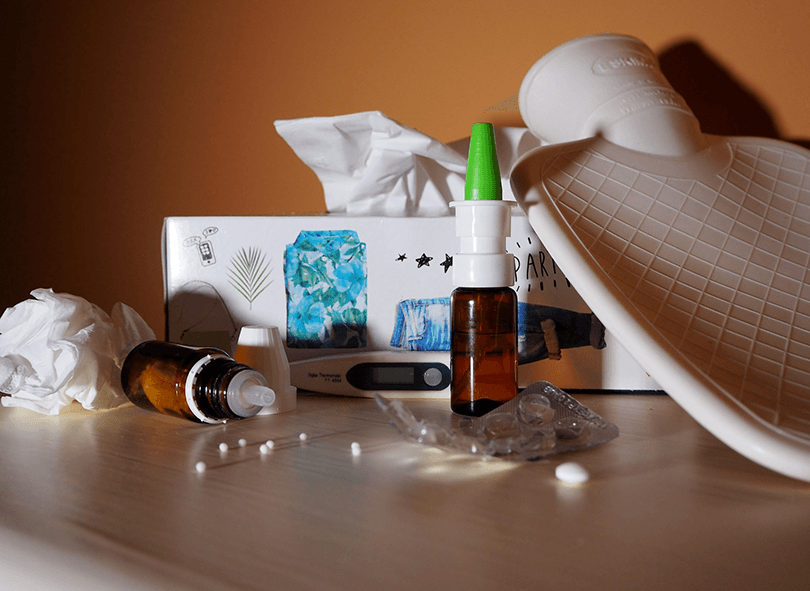Wondering how to stay healthy when it seems like everyone has the flu? Here’s some information that should help you understand what’s going on and how to reduce your risks of getting it.
Influenza: The Basics
Influenza is a highly contagious respiratory illness caused by influenza viruses that infect the nose, throat and sometimes the lungs. It can cause mild to severe illness and at times can lead to death. The best way to prevent the flu is by getting a flu vaccine each year.
Signs and Symptoms of Flu
People who have the flu typically experience any or all of these signs and symptoms that usually start suddenly within hours, not days:
- Fever, usually greater than 100 or feeling feverish/chills
- Cough (usually not producing much mucous)
- Sore throat
- Runny or stuffy nose
- Muscle or body aches, headaches
- Fatigue (very tired)
- Vomiting and diarrhea (more common in young children than in adults)
How Flu Spreads
The flu viruses spread mainly by tiny droplets made when people with flu cough, sneeze or talk. These droplets can land in the mouths or noses of people who are nearby. Less often, a person might also get flu by touching a surface or object that has flu virus on it and then touching their own mouth, nose, or eyes.
Period of Contagiousness
You may be able to pass on the flu to someone else before you know you are sick, as well as while you are sick. Although people with the flu are most contagious in the first 3-4 days after their illness begins, some otherwise healthy adults may be able to infect others beginning 1 day before symptoms develop and up to 5 to 7 days after becoming sick. Some people, especially young children and people with weakened immune systems, might be able to infect others with flu viruses for an even longer time.
Onset of Symptoms
The time from when a person is first exposed to flu virus and infected to when symptoms begin is about 1 to 4 days, with an average of about 2 days.
People at High Risk from Flu
Anyone can get the flu (even healthy people), and serious problems related to the flu can happen at any age. However, some people are at high risk of developing serious flu-related complications, including people over 65 years of age, pregnant women, young children, smokers, and people of any age with certain chronic medical conditions (e.g., weakened immune system due to illness or medications, chronic infections, asthma, diabetes, heart disease, as well as lung, liver or kidney problems).
Complications of Flu
Most people with the flu have mild illness and do not need medical care or antiviral drugs. Complications of the flu include bacterial pneumonia, ear infections, sinus infections, strep throat, and worsening of chronic medical conditions, such as congestive heart failure, asthma, or diabetes.
Preventing Seasonal Flu: The Best Way to Prevent the Flu is to get a Flu Shot every year
The first and most important step in preventing flu is to get a flu vaccination each year. CDC also recommends everyday preventive actions (like staying away from people who are sick, covering coughs and sneezes and frequent handwashing) to help slow the spread of germs that cause respiratory (nose, throat, and lungs) illnesses, like flu.
** The Student Health Services Clinic provides flu vaccines for students. Call 706-721-3448 to schedule appointment or simply walk in Mondays – Fridays 8:00AM to 4:30PM. Cost is only $28.00. The vaccine is free for students with the State of Georgia Student Health Insurance plan from United Healthcare Resource. **
Diagnosing Flu
It is very difficult to distinguish the flu from other viral or bacterial causes of respiratory illnesses on the basis of symptoms alone. There is a simple lab test available at the Student Health Clinic to diagnose flu with good specificity and adequate sensitivity.
Treating Flu
If you get sick with mild flu symptoms, in most cases, you should stay home and avoid contact with other people except to get medical care. If however, you have moderate flu symptoms and especially if you are in a high risk group, you should be seen by a health care provider. Since there is no cure, you essentially treat the symptoms. There are prescription influenza antiviral drugs that may be useful in shortening the duration and lessening the severity of influenza symptoms but essentially, the virus needs to run its 7-10 day course.
General treatment recommendations; consult your medical provider for details:
- For fever, aches, headaches: Acetaminophen/Tylenol 325mg tab’s, take two every 6-8 hours as needed
- For cough: Robitussin DM or Delsym, or Mucinex if you have congestion
- For sore throat (uncomplicated): throat lozenges, gargle with warm salt water
- For sinus congestion: Pseudoephedrine (Sudafed) or similar products, sinus rinses, NasalMist, use humidifier/breath steam
- For runny nose, watery eyes, etc.: Allergy medication (e.g., Benadryl, Dimetapp, Zyrtec, Claritin, Allegra)
- For multi-symptoms: Dayquil or Nyquil
- Use a warm heating pad for aching muscles.
- Rest at home and drink warm fluids with honey and lemon
- Do not give aspirin to children under age 18.
Take precautions to limit the spread of flu to others by practicing good hygiene, washing hands frequently, using sanitizers, not sharing food or drinks, and avoiding close contact with other people as much as possible.
What are the emergency warning signs of the flu?
Report to the emergency room should you develop any of the following emergency warning signs of the flu:
- fever greater than 103 and chills,
- difficulty breathing, shortness of breath
- severe persistent cough that produces thick yellow-brown mucus,
- dizziness, confusion
- chest pain with breathing, abdominal pain
- severe or persistent vomiting
- severe earache, sinus pain, headache or neck pain/stiffness.
When should a student contact the Student Health Services or be seen at urgent care?
If your symptoms worsen but not to the level of having emergency warning signs, (e.g., persistent cough, fever, sore throat, earache, sinus pain, etc.), contact Student Health.
If you develop warning signs of the flu as noted above, go to the emergency room.
 Augusta University
Augusta University




